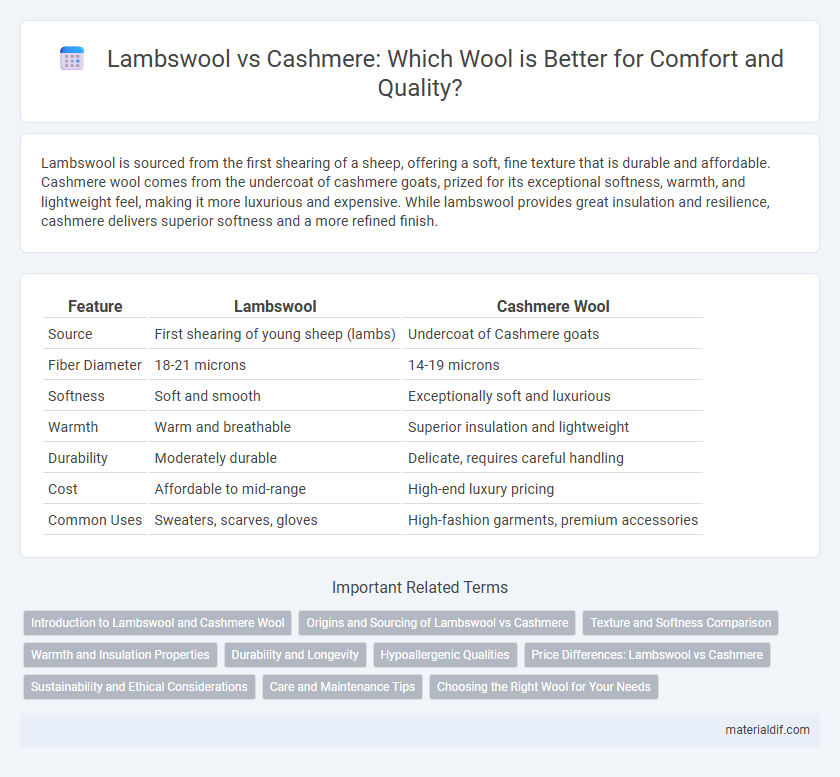Lambswool is sourced from the first shearing of a sheep, offering a soft, fine texture that is durable and affordable. Cashmere wool comes from the undercoat of cashmere goats, prized for its exceptional softness, warmth, and lightweight feel, making it more luxurious and expensive. While lambswool provides great insulation and resilience, cashmere delivers superior softness and a more refined finish.
Table of Comparison
| Feature | Lambswool | Cashmere Wool |
|---|---|---|
| Source | First shearing of young sheep (lambs) | Undercoat of Cashmere goats |
| Fiber Diameter | 18-21 microns | 14-19 microns |
| Softness | Soft and smooth | Exceptionally soft and luxurious |
| Warmth | Warm and breathable | Superior insulation and lightweight |
| Durability | Moderately durable | Delicate, requires careful handling |
| Cost | Affordable to mid-range | High-end luxury pricing |
| Common Uses | Sweaters, scarves, gloves | High-fashion garments, premium accessories |
Introduction to Lambswool and Cashmere Wool
Lambswool, harvested from the first shearing of a sheep, is soft, fine, and highly breathable, making it ideal for lightweight sweaters and scarves. Cashmere wool, obtained from the undercoat of Cashmere goats, is renowned for its exceptional softness, warmth, and luxurious feel, often considered a premium material in high-end fashion. Both fibers offer excellent insulation and comfort, but cashmere is typically more expensive due to its rarity and labor-intensive harvesting process.
Origins and Sourcing of Lambswool vs Cashmere
Lambswool is sourced from the first shearing of young sheep, typically around seven months old, primarily from Merino or other fine-wool sheep breeds. Cashmere is harvested from the undercoat of Cashmere goats, predominantly found in Mongolia, China, and parts of Iran, where harsh climates stimulate the growth of fine, soft fibers. The origins and sourcing of these wools greatly influence their texture and value, with lambswool being more widely available and cashmere considered a luxury due to its limited and labor-intensive collection process.
Texture and Softness Comparison
Lambswool, harvested from young sheep, features a fine, smooth texture that is soft yet slightly denser than cashmere, providing warmth with a gentle feel against the skin. Cashmere, derived from the undercoat of cashmere goats, is renowned for its ultra-fine fibers that deliver exceptional softness and lightweight warmth, surpassing lambswool in delicate texture and plush comfort. Both fibers offer premium softness, but cashmere's superior fineness and loft create a silkier, more luxurious tactile experience.
Warmth and Insulation Properties
Lambswool offers excellent warmth and insulation due to its fine, soft fibers that trap heat efficiently, making it ideal for cold weather garments. Cashmere wool provides superior insulation with its ultra-fine fibers that create lightweight, breathable warmth while maintaining exceptional softness. Both fibers excel in thermal retention, but cashmere's insulating properties surpass lambswool, delivering a higher warmth-to-weight ratio.
Durability and Longevity
Lambswool, sourced from the first shearing of young sheep, is known for its durability and resilience, making it ideal for daily wear and long-lasting garments. Cashmere wool, derived from the soft undercoat of cashmere goats, offers exceptional softness but typically requires more delicate care due to its finer fibers, which can be less durable over time. While lambswool provides robust longevity, cashmere excels in luxury and softness, often demanding more careful maintenance to preserve its lifespan.
Hypoallergenic Qualities
Lambswool and cashmere wool both exhibit hypoallergenic qualities, making them suitable for sensitive skin, though lambswool tends to have a slightly coarser fiber that may cause mild irritation in some individuals. Cashmere, derived from the soft undercoat of cashmere goats, boasts finer and less allergenic fibers, reducing the likelihood of allergic reactions or itchiness. Both wools are naturally breathable and moisture-wicking, enhancing comfort and minimizing allergens commonly associated with synthetic fibers.
Price Differences: Lambswool vs Cashmere
Lambswool is generally more affordable than cashmere due to its abundance and easier sourcing from young sheep, whereas cashmere, derived from the soft undercoat of cashmere goats, commands a premium price because of its rarity and labor-intensive collection. Price per pound of lambswool typically ranges from $20 to $40, while cashmere can cost between $150 and $300, reflecting its luxury status and higher quality. The significant cost difference impacts consumer choice, with lambswool favored for budget-friendly warmth and cashmere preferred for luxury softness and insulation.
Sustainability and Ethical Considerations
Lambswool is derived from the first shearing of young sheep, making it a renewable resource with a lower environmental impact compared to cashmere, which comes from the undercoat of cashmere goats and requires more extensive land use and water consumption. Cashmere production often raises ethical concerns due to overgrazing, habitat degradation, and the intensive labor required for combing fibers, whereas lambswool farms generally follow more sustainable grazing practices. Choosing lambswool supports animal welfare and reduces ecological footprint, aligning better with ethical fashion and sustainability goals.
Care and Maintenance Tips
Lambswool requires gentle washing in cold water with mild detergent to preserve its softness and prevent shrinkage, while cashmere demands even more delicate care, including hand washing or dry cleaning to maintain its luxurious feel and avoid pilling. Both fibers benefit from air drying flat away from direct heat and sunlight to prevent damage. Storing lambswool and cashmere garments in breathable cotton bags with cedar balls can protect against moths and maintain fiber quality.
Choosing the Right Wool for Your Needs
Lambswool, sourced from the first shearing of young sheep, offers a soft, durable, and breathable textile ideal for everyday wear and moderate climates. Cashmere, harvested from the undercoat of cashmere goats, provides exceptional warmth, lightweight comfort, and a luxurious feel perfect for sensitive skin and colder environments. Choosing between lambswool and cashmere depends on budget considerations, desired softness, insulation needs, and the intended use of the garment.
Lambswool vs Cashmere wool Infographic

 materialdif.com
materialdif.com